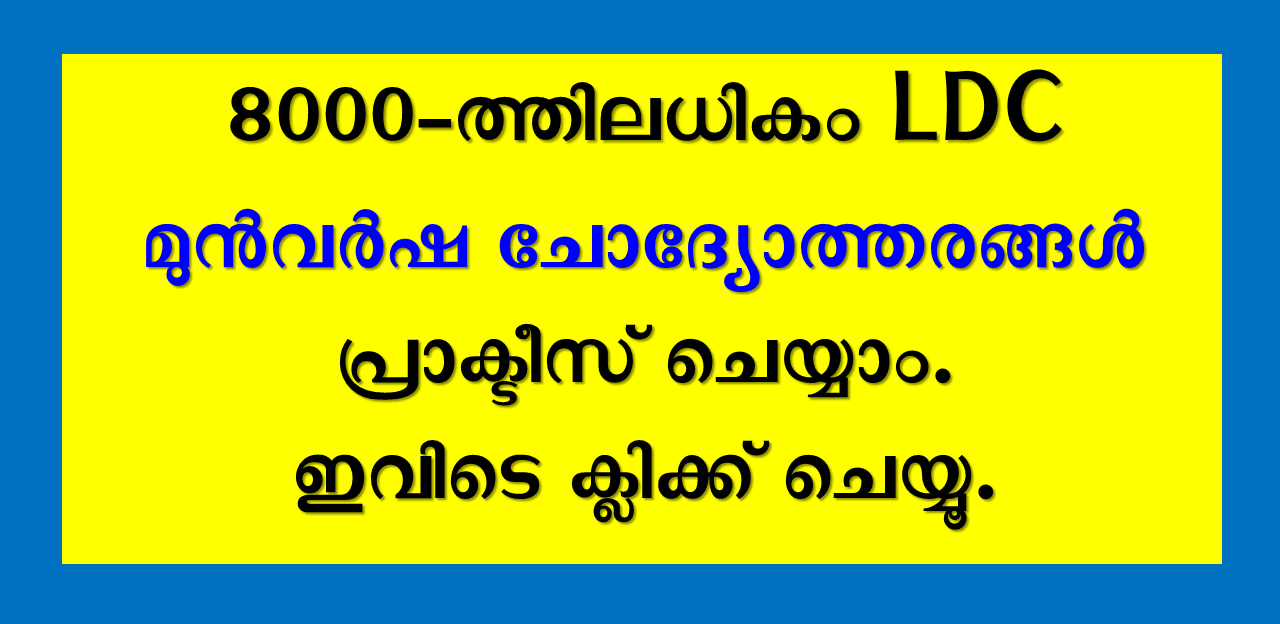PSC HSST History SR for SC/ST Model Questions and Answers
PSC HSST History Model Questions and Answers: Here are the model questions and answers for HSST History SR for SC/ST PSC examination. These are the previous asked questions for the PSC HSST History Examination.
PSC HSST History SR for SC/ST Model Questions and Answers
Question Paper Code: 65/2016/OL
Category Code: 575/2014
Exam: HSST HISTORY SC/ST JR SR
Date of Test: 08-08-2016
1. The Autobiography of Justice V. R. Krishna Iyer is
(A) Prabhuddha Bharata (B) Karma Yogi
(C) Wandering in Many Worlds (D) Common Weal
Answer: C
2. The first Travelogue in Malayalam language named Varthamana Pusthakam was written by
(A) Paremakkil Thoma Kattanar (B) Varghese Vaidhyan Kattanar
(C) Kanai Thomman (D) Marthoma Kattanar
Answer: A
3. To which field is ‘KIRAN’ related ?
(A) Energy sector (B) Female scientist
(C) Film industry (D) Environment
Answer: B
4. In which year the Travancore government issued orders permitting the Channar women to wear jacket and pinafore made of raw cotton ?
(A) 1857 (B) 1858
(C) 1856 (D) 1859
Answer: D
5. Jaikumar Garg has been appointed as MD and CEO of which Central Government owned bank ?
(A) Corporation Bank (B) SBT
(C) SBI (D) Corporate Bank
Answer: A
6. The social reform leader from Tamil Nadu who arrived at Vaikom during the Satyagraha?
(A) V. V. Giri (B) karuna Nidhi
(C) E. V. Ramerwari Naikar (D) Mooppanar
Answer: C
7. Which of the following is the lowest point of Africa ?
(A) Lake Tangunjika (B) Lake Chad
(C) Lake Malawi (D) Lake Assal
Answer: D
8. The research work in the field of linguistic written by Chattampi Swamikal ?
(A) Vedanta (B) Adi Bhasham
(C) Advanitam (D) Bhasham
Answer: B
9. The famous drama written by K. Damodaran was
(A) Red Volunteer (B) Inquilab Zindabad
(C) Manjari (D) Pattabakki
Answer: D
10. Write the abbreviated form of ICHR ?
(A) Indian Centre for Historical Research
(B) International Council for Historical Research
(C) Indian Council for Historical Research
(D) International Centre for Historical Research
Answer: C
11. The type of research that makes use of systematic procedures to discover non-quantifiable relationships between existing variables is
(A) Historical Research (B) Qualitative Descriptive Research
(C) Experimental Research (D) Action Research
Answer: B
12. An expert teacher is one who
(A) Knows the content of the subject they teach
(B) Knows to relate the content to the world outside
(C) Knows to keep students involved in learning
(D) All of the above
Answer: D
13. The pretest-posttest equivalent groups design is a type of
(A) Pre-experimental design (B) True-experimental design
(C) Quasi-experimental design (D) Factorial design
Answer: B
14. Subdividing the population in to smaller homogenous groups to get more accurate representation is
(A) Systematic sampling (B) Area sampling
(C) Stratified random sampling (D) Cluster sampling
Answer: C
15. Teaching efficacy means a teacher’s belief
(A) in her teaching abilities and skills
(B) that she can reach even difficult students to help them learn
(C) in her subject competency
(D) that she is a successful reflective practitioner
Answer: B
16. An evaluation tool that communicates the achievements of individual students over time
(A) Portfolios (B) Achievement Test
(C) Graphic Organiser (D) Rubric
Answer: A
17. The characteristic that distinguishes descriptive research from assessment and evaluation is
(A) Hypothesis formulation
(B) Hypothesis formulation and testing
(C) Analysis of the relationships between non-manipulated variables
(D) Development of generalisation
Answer: D
18. The area where the child cannot solve a problem alone, but can be successful under adult guidance
(A) Zone of potential development
(B) Zone of actual development
(C) Zone of proximal development
(D) Zone of cultural development
Answer: C
19. A well written introduction of a research report must have
(A) a clear statement of the problem
(B) a review of previous literature on the topic
(C) a formal statement of each hypothesis
(D) all of the above
Answer: D
20. The composite of ideas, feelings and attitudes people have about themselves is termed
(A) Self-concept (B) Self-esteem
(C) Autonomy (D) Initiative
Answer: A
21. With respect to the Constitution of India, consider the following :
1) Fundamental Rights
2) Fundamental Duties
3) Directive Principles of State Policy.
Which of the above is/are fulfilled by the National Social Assistance Programme launched by the Government of India ?
(A) Only 1)
(B) Only 2)
(C) 1) and 3)
(D) 2) and 3)
Answer: C
22. What does the 104th Constitutional Amendment Bill related to ?
(A) Abolition of legislative councils in certain states
(B) Providing quota to socially and economically backward classes in private educational institutions
(C) Introduction of dual citizenship for persons of Indian origin abroad
(D) Allotting quota for religious minorities in central government service
Answer: B
23. Who was the Chief Justice of India when public interest litigation was introduced to the Indian Judicial System ?
(A) M. Hidayathullah (B) A. M. Ahmedi
(C) A. S. Anand (D) P. N. Bhagavati
Answer: D
24. Read the following statements :
1) The Governor of Punjab is concurrently the administrator of Chandigarh.
2) The Governor of Kerala is concurrently the administrator of Lakshadweep.
Which of the above statement(s) is/are correct ?
(A) Only 1) (B) Only 2)
(C) Both 1) and 2) (D) Neither 1) nor 2)
Answer: A
25. Consider the following statements :
1) Central Administrative Tribunal (CAT) was set up during the Prime Ministership of Lal Bahadur Shastri.
2) The members of CAT are drawn from both judicial and administrative streams.
Which of the above statement(s) is/are true ?
(A) Only 1) (B) Only 2)
(C) Both 1) and 2) (D) Neither 1) nor 2)
Answer: B




